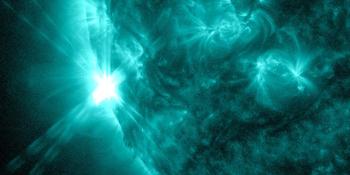Tarkastellaan torstaina, 19. kesäkuuta 2003 arkistoa
Auringon aktiivisuusraportti
Kaikkiin tässä raportissa mainittuihin auringonpurkauksiin on sovellettu Space Weather Prediction Center:n (SWPC) skaalauskerrointa. SWPC:n skaalauskertoimen vuoksi flarepurkaukset ilmoitetaan 42 prosenttia pienempinä kuin tieteellisissä laatutiedoissa. Skaalauskerroin on poistettu arkistoidusta auringonpurkaustiedostamme, jotta se vastaisi todellisia fyysisiä yksiköitä.
Raportti geofysikaalisesta aktiivisuudesta 2003 Jun 19 2200 UTCValmisteli NOAA © SWPC ja käsitteli SpaceWeatherLive.com
USAF:n ja NOAA:n yhteinen raportti Auringon ja geofysikaalisesta aktiivisuudesta
SDF-luku 170 julkaistu 2200Z kello 19 Jun 2003IA. Auringon aktiivisten alueiden ja aktiivisuuden analyysi välillä 18-2100Z – 19-2100Z Solar activity decreased to very low levels. Flare
activity was limited to several B-class flares. Region 386 (S07E30)
lost penumbral coverage over the period although it does retain a
delta magnetic structure in the dominant lead spot. Region 387
(N18E49) grew in both penumbral coverage and magnetic complexity
since yesterday, a gamma structure is now evident in the trailing
portion of the spot group. Newly numbered Region 388 (S03E08)
produced a minor B-class flare early in the period.
IB. Auringon aktiivisuusennuste
Solar activity is expected to be at
moderate levels. Region 386 remains capable of producing an
isolated major flare.
IIA. Geofysikaalisen aktiivisuuden yhteenveto 18-2100Z – 19-2100Z
The geomagnetic field was at predominantly active levels today.
Minor storm conditions were observed at both middle and high
latitudes between 19/0000 and 0300Z due to the influence of a
recurrent high speed coronal hole stream. The greater than 10 MeV
proton flux exceeded event threshold at 18/2050Z (reached a max of
24 pfu at 19/0450Z), ended at 19/1900Z and after careful review the
event is believed to have been the result of the M6.8 x-ray flare
from June 17. The greater than 2 MeV electron flux reached moderate
levels today.
IIB. Geofysikaalisen aktiivisuuden ennuste
The geomagnetic field is
expected to be at predominantly unsettled to active levels through
the interval. Minor storm conditions may exist due to a transient
passage during the first half of day one in response to the M6.8
x-ray flare from June 17.
III. Tapahtuman todennäköisyydet 20 Jun – 22 Jun
| Luokka M | 50% | 50% | 50% |
| Luokka X | 15% | 15% | 15% |
| Protonit | 25% | 15% | 15% |
| PCAF | green | ||
IV. Penticton 10,7 cm vuo
Havaittu 19 Jun 123 Ennusteet 20 Jun-22 Jun 125/125/125 90 vuorokauden keskiarvo 19 Jun 124
V. Geomagneettinen A-indeksit
Havaittu Afr/Ap 18 Jun 036/054 Arvioitu Afr/Ap 19 Jun 023/025 Ennusteet Afr/Ap 20 Jun-22 Jun 020/025-020/025-012/020
VI. Geomagneettisen toiminnan todennäköisyydet 20 Jun – 22 Jun
| A. Keskileveysasteet | |||
|---|---|---|---|
| Aktiivinen | 40% | 40% | 25% |
| Heikko myrsky | 15% | 15% | 10% |
| Voimakas myrsky | 10% | 10% | 05% |
| B. Korkeat leveysasteet | |||
|---|---|---|---|
| Aktiivinen | 50% | 50% | 40% |
| Heikko myrsky | 20% | 20% | 15% |
| Voimakas myrsky | 10% | 10% | 10% |
Kaikki ajat ovat UTC-aikoja
<< Siirry päivittäiselle yleiskatsaussivulle
Uusimmat uutiset
Viimeisimmät foorumiviestit
AR 13730 7Unspecified geomagnetic activity 1150Incoming Active Regions 579Partial Halo CME 2024/06/29 16:00 14A R 3729 7
Lisää aiheitaTue SpaceWeatherLive.com -sivustoa!
Monet ihmiset seuraavat SpaceWeatherLive -sivuilta Auringon toimintaa tai onko revontulia, mutta kun on enemmän liikennettä sitä suuremmat ovat palvelimen kustannukset. Harkitse lahjoitusta, jos pidät SpaceWeatherLivestä, jotta voimme pitää edelleen verkkosivustomme saatavilla!

Avaruussäätiedot
| Viimeisin X-flare | 10/06/2024 | X1.55 |
| Viimeisin M-flare | 01/07/2024 | M2.1 |
| Viimeisin geomagneettinenmyrsky | 28/06/2024 | Kp8- (G4) |
| Pilkuttomat vuorokaudet | |
|---|---|
| Viimeisin auringonpilkuton vuorokausi | 08/06/2022 |
| Kuukausittainen auringonpilkkuluku | |
|---|---|
| toukokuuta 2024 | 171.7 +35.2 |
| Viimeiset 30 päivää | 155.8 +6.7 |


